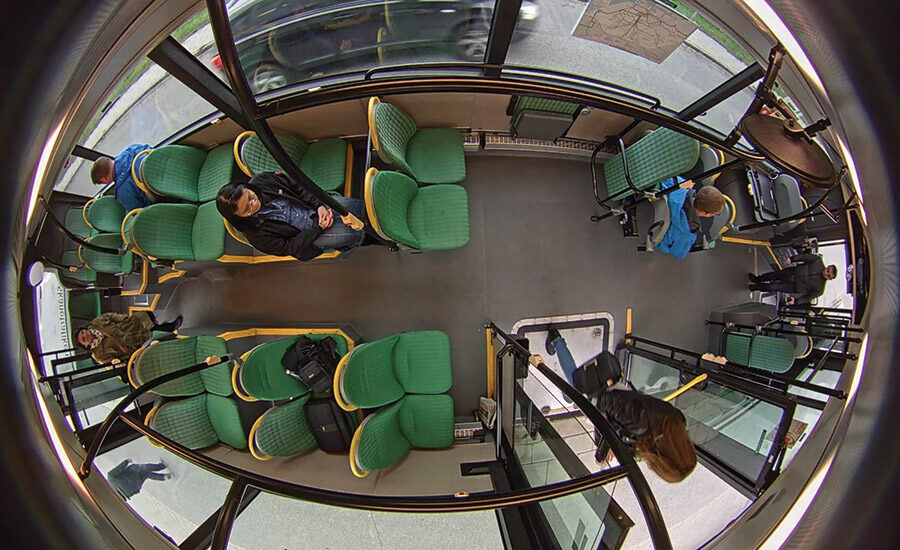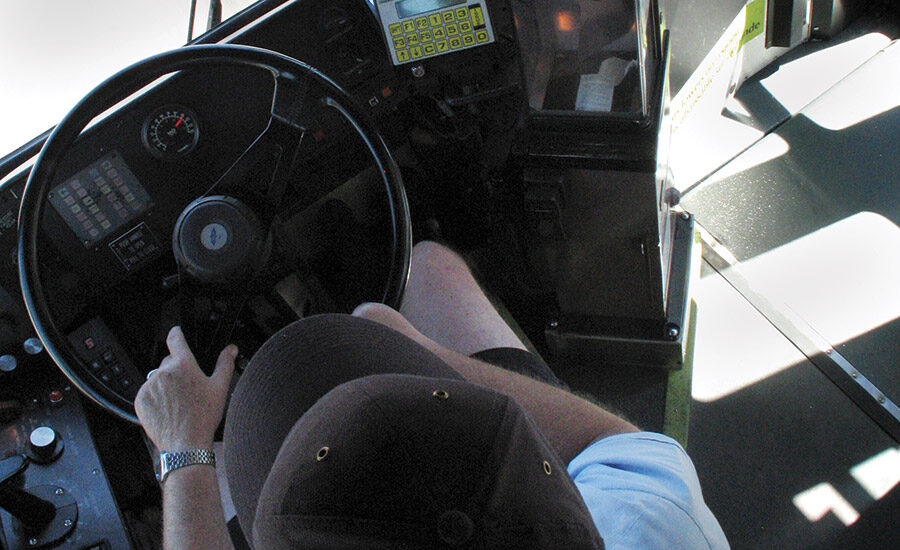Growth in Mobile and Transportation Surveillance


Fisheye cameras are typically installed on the ceiling of buses or train cars to provide a full view of the space, which is complemented by additional standard cameras placed throughout and even on the outside of the bus or car.
PHOTO COURTESY OF AXIS COMMUNICATIONS

As many as six to eight cameras may be installed on each bus or in each rail car to capture a variety of video, including monitoring drivers to determine whether they are following established policies and procedures or to aid with an investigation following an incident.
PHOTO COURTESY OF MARCH NETWORKS

High-profile events in 2015 have generated awareness of the value of body-worn cameras for law enforcement officers and agencies, but the potential opportunity for traditional security camera manufacturers and integrators alike remains to be seen.
PHOTO COURTESY OF WOLFCOM ENTERPRISES




The mobile surveillance market, particularly in the transportation and law enforcement sectors, grew incredibly rapidly in the last year — faster than a speeding bullet (train), one could say. Naturally, security is a main driver behind this growth, with the desire to gather evidence for investigating liability and other types of incidents also significantly contributing.
“We live in a litigious society, and a lot of video is used for risk management,” says Anthony Incorvati, director of business development, critical infrastructure and transportation, Axis Communications, Chelmsford, Mass. “You have people file slip-and-fall claims, some rightfully so. In those cases, video can be used as a tool to provide a higher level of intelligence and figure out how to correct things moving forward.”
Within the mobile surveillance market, body-worn cameras also gained significant traction in 2015. The vast majority of this growth was in the consumer space, but law enforcement is a growing segment as well, based largely on high-profile incidents involving officers. For more on the impact of and potential opportunities for these technologies, see “The Outlook (and Opportunity?) for Body-Worn Cameras” on page 130.
Mobile license plate recognition (LPR) technologies are the best way to scan large numbers of license plates to alert of vehicles of interest.
Outfitting buses and trains with surveillance equipment can aid with increasing ridership in multiple ways. Technology can be a cornerstone of a strategy to increase passenger safety and video can be sampled for data to optimize routes and schedules based on demand.
Vehicle recording and tracking has been a growing technology for law enforcement. Another emerging technology includes body-worn cameras.
“There’s been a lot of grant money put toward cameras on subways and trains,” says Tom Cook, vice president of sales and marketing, North America, Samsung Techwin America, Ridgefield Park, N.J. “I don’t know if you need higher resolution than standard HD because of the limited viewing distance. These projects are very price-driven because they’re funded with public money, so the low bid wins a lot of the time. It’s more about the price than the technology, so standard full-HD is enough for them.”
Mirroring the Industry
Transportation surveillance is certainly not new; it’s been around for many years. A newer trend in the space, however, is one that has driven the security industry in general for many years now — namely, the move toward IP systems.
“Transportation is one of the last segments that’s holding on to analog,” Incorvati says. “We’re seeing a transition, with a number of major RFPs in the last year or two with true end-to-end IP video. I’m convinced that every form of public transportation, whether bus, rail or other vehicle, will — even if they’re currently analog — be IP-driven.”
Cook agrees. “Technology-wise, in the past, we’ve seen analog dominate. Just now we’re seeing an understanding among end users that they could put in an HD IP solution for a decent price,” he says.
PoE is another main benefit of installing IP as opposed to analog systems, eliminating the need to run multiple cables for powering and transmitting video between both the recorder and camera.
“The in-vehicle NVR is connected to the vehicle power via specialized wiring harnesses, and cameras are connected to and powered from the NVR using PoE,” says Brian Carle, director of product strategy, Salient Systems, Austin, Texas.
The move to IP has also opened up many more applications for transportation and mobile surveillance, which are in turn accelerating demand.
“Security is one of the clear uses, but we’re seeing more and more uses and users,” Incorvati says. “Because IP video image quality is greater, it provides the flexibility to open the door for more users, with operations, maintenance, cleaning and other departments becoming big drivers of video surveillance systems.”
Video Transfer
In the past, analog systems used for buses, trains and other transport types consisted of cameras connected directly to DVRs in a self-contained ecosystem. Both cameras and recorders were powered either by battery or through a connection to the vehicle itself.
Offloading video was largely a manual process that involved someone physically interacting with the recorder. While less than an ideal solution, that model continues to exist today largely in situations where there are budgetary or bandwidth challenges, it’s certainly not the method of choice.
What nearly all end users want, Carle says, is the ability to automatically offload video onto a central server for archiving. With these types of systems, when the vehicle returns to a depot or other facility where a wireless network has been set up, the mobile recorder detects the network and begins transferring video to a centralized storage server.
This type of solution would be ideal for most users, and has often been deployed successfully. The caveat, however, is that Wi-Fi is not always a magic — or even the most reliable — technology.
“It takes a lot of bandwidth to download four to eight hours of video onto a server, and that’s just from one bus. What if there are 10? You’re looking at some hefty bandwidth use,” Cook says. “What if it gets disconnected? How can you tell where it left off and how to recover what’s missing? It’s not so simple; there’s definitely a trickiness to doing it automatically, and that’s been the hitch in a lot of plans and products. Right now, the most reliable way to transfer video to the server is manually.”
That said, it’s only a matter of time until auto-offloading via wireless is reliable and accessible enough to be used by a wider range of end users. “As technologies improve and wireless costs continue to drop, we’re seeing smarter solutions starting to emerge, so there will be a day when end users will be able to realize that,” Incorvati says.
Integrated Systems
Older analog-based mobile surveillance systems have traditionally been provided by a family of companies as turnkey offerings that delivered end-to-end functionality. With the rise of IP in transportation, that is changing rapidly.
“The world is changing, and end users want a lot more,” Incorvati says. “They want integration with other systems that provides the flexibility to use more types of VMS for more open integrations.”
The ability to integrate systems also opens the door to potentially sharing transit video with law enforcement, which is becoming a more significant application for these systems, Carle says.
“Technologies that allow sharing of video across different organizations can be a key tool for police, emergency management and other municipal organizations that would benefit from being able to access video deployed by a municipal transit authority,” he says. “In these cases, separate organizations may standardize on a recording platform to enable compatibility of viewing and investigation software, or a PSIM product may be deployed to connect several disparate technologies.”
Because many of the subsystems within trains, including GPS, computer aided dispatch (CAD) and automatic vehicle location (AVL) systems, have already transitioned to IP, integrating IP surveillance has become much easier and more seamless, says Dan Cremins, director, product line management, March Networks, Ottawa, Ontario, Canada. “With these types of smart bus technologies, you’re able to find out where and when there were any major problems, for example, or determine whether the bus was on its route at the time,” he says.
The ability to associate metadata, such as time, location, activation of a particular system or other factor, with video allows users to find specific incidents quickly, significantly aiding with investigation and planning, says Real Barriere, product line manager – transit solutions, for March Networks. “Video surveillance on board a train or bus captures data, but what really matters at the end of the day is what you do with it,” he describes.
Expanding Opportunities
Another new development that’s not unrelated to the move to IP systems is the opening of the mobile and transportation surveillance market to a broader base of integrators. Traditionally, this market has been limited to a set of niche providers who focused solely on the needs and requirements of transportation.
“Historically, there has been a group of specialized integrators who played in this space. The main reason is the risk associated with deployments in these types of environments,” Incorvati says. “Because of the way technology is moving with the adoption of IP, that will open up more integrators into the space.”
That’s not to say getting into transportation is an easy task. The requirements and deliverables are still much different from those for more traditional fixed systems, Incorvati says. “If you’ve only done elementary schools and strip malls, you really have to think it through and make sure you understand the requirements and deliverables beyond the technology. It’s not for the weak,” he says. “There are a lot of challenges just working in and around a rail environment, working with unions and intermittent periods of time you can work — say, 12 a.m. to 5 a.m. — and things like that.”
Cook says he’s already seen a number of security professionals making the move. “There are a lot of integrators coming into this space with the growth IP solutions. It’s been mainly niche companies that focus on that market, but now we’re seeing a larger base working in transportation,” Cook says.
For some integrators, the transition may be less difficult than it would be for others based on previous experience. “Integrators who have worked in mission-critical areas and understand project deliverables, have strong project management within their organization and understand the meaning of true systems integration — those are the integrators that are starting to emerge and come into the transportation space,” Incorvati says.
The Right Equipment for the Job
When dealing with moving vehicles, constant motion, extreme temperatures and other factors could wreak havoc on surveillance equipment both physically and in terms of performance. Take simple cabling, for example.
Anyone who’s ever connected a Cat5 cable to their computer knows that the plastic clip that holds the cable in place can break very easily, allowing it to fall out of the port. The vibration of a bus or train only exacerbates this. That’s why for transportation, MJ-12 connectors are commonly used. Built to military standards, these metal twist connectors will withstand vibration and other elements to prevent gaps in video recording from cameras coming disconnected.
Thankfully, polycarbonate bodies, military-grade connectors, conformal coatings to provide weather and water proofing, vibration-correction algorithms and other technologies are all fairly common in today’s equipment.
“Everything has been figured out already by other spaces,” says Ian Johnston of Digital Watchdog. “A cost-effective balance between military specifications and consumer specifications can usually be reached by an integrator willing to educate themselves.”
So all that’s left for integrators to do is ensure the products they’re using are among those that offer these features. To that end, an important term to know when working in transportation is EN 50155, a European standard for electronics in railway applications, which is generally accepted as the global standard for temperature, humidity, shock and vibration and other parameters. Basically, if a camera or recorder doesn’t meet those or similar standards, it has no place in a mobile or transit application.
The Outlook (and Opportunity?) for Body-Worn Cameras
Driven by the popularity of consumer technologies such as GoPro, the market for wearable cameras experienced tremendous growth in 2015 and shows no signs of slowing anytime soon. According to technology market research firm Tractica, the market for body-worn cameras is expected to reach more than $50 billion by 2020, based on projected sales of more than 30 million cameras. By comparison, an estimated 6 million body-worn cameras were sold in 2015, generating revenues in the neighborhood of $15 billion.
“Body-worn cameras represent a huge opportunity,” says Sam Belbina, director, strategic sales for City of Industry, Calif.-based Hikvision USA. “Wearable technology is growing at staggering numbers, and we’re seeing body-worn cameras used in all sorts of walks of life — you can wear them or stick them on the dashboard or even on a bike.”
Within the overall body-worn camera segment is an increasing demand within the law enforcement space, which stems from a number of recent high-profile events that have raised questions about officers’ conduct in certain situations. In May 2015, the U.S. Department of Justice awarded more than $23 million in funding for a pilot program to provide body-worn cameras, training and technical assistance to law enforcement in 32 states, and to study the impact of these grants. More funding may be on the way, as President Obama has requested a spending package that would provide an additional $75 million to cover half the expense of lapel-mounted cameras for agencies nationwide, with the remainder of costs to be covered by state and local governments.
“We saw a lot of activity in the body-worn camera segment in the second half of last year, as we continue to see a move toward more and more law enforcement officers needing to wear body cameras as a result of mandates and grants,” says Christie Hamberis, president of Greenville, S.C.-based distributor ScanSource.
The explosive growth in the segment hasn’t made it easy for camera manufacturers to determine how — or even if — they should enter the body-worn camera market, leading to the industry lagging behind the consumer market.
“Because of recent events, this segment came on very strong and very quick. That didn’t leave much time for truly understanding the needs and development,” says Sean Murphy, regional marketing manager, Bosch Security, Fairport, N.Y. “This trend is worth watching as it evolves with both new legislation and potential new innovations. It’s not currently a market we are engaged in, but we do continue to monitor for potential crossover into our portfolio direction.”
Despite the potential opportunities in the body-worn camera space, there are drawbacks at the moment, particularly for systems integrators.
“There’s been a lot of activity on this, but since there are a lot proprietary systems that do not fully integrate with the normal VMS companies, there isn’t much revenue for integrators,” says Tom Larson, director of sales and engineering, BCDVideo, based in Northbrook, Ill.
Simply getting in the door to compete for projects could prove to be too daunting for a lot of integrators. Ian Johnston, chief technology officer of Digital Watchdog, Cerritos, Calif., says that because law enforcement agencies and municipal governments are used to doing things a certain way, it can be hard for integrators who don’t “speak the language” of procurement.
“For many of these infrastructure jobs, the purchasing and specifications are driven by folks that don’t have an extensive knowledge of what is available on the market,” he says. “As such, decisions are made based on what is best for them, or what they have been sold as the ‘best’ solution. The net result is this is a very difficult market to break into. Even if you have a much better solution, it can easily lose to a more popular and/or a vendor that knows how to play the game.”
Another major hurdle, Cook says, is that the industry and law enforcement haven’t yet nailed down specifics about just what departments want or need in body-worn cameras.
“There’s all kinds of grant money going toward body-worn cameras for law enforcement, but the problem is what exactly do they want?” he says. “It’s difficult to nail down specifically what a camera should be and what it should do, and how it will connect to their system. It’s more than just a battery-operated camera that clips on an officer’s collar or chest. The officer could be blocking the shot or their body might not be facing where they’re looking, so they’re not capturing the video they need.”
Despite all the challenges and questions surrounding the technology, it’s no longer a question of if traditional security manufacturers will move into the body-worn camera market, but when that might happen. This development should also lead to more open solutions that integrate with VMS and other systems.
Looking for a reprint of this article?
From high-res PDFs to custom plaques, order your copy today!












